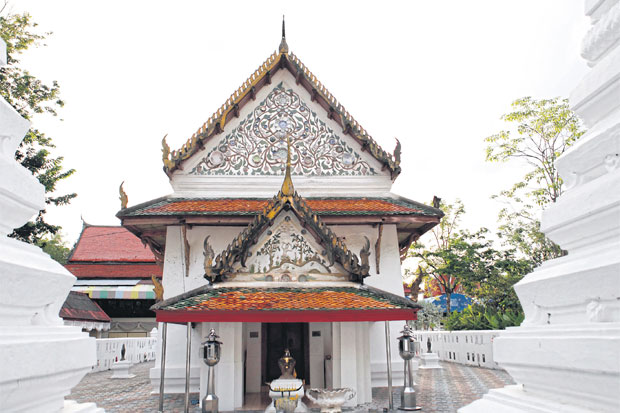A raised concrete walkway behind Wat Champa in Taling Chan leads to the Koh San Chao canal community. The community might not ring a bell, but it is known among a few travellers as an add-on trip to the famous Lat Mayom floating market in Taling Chan.

The community preserves their old way of living, especially the traditional method of making paeng phuang or traditional scented powder garlands and local snacks.
"Our community can be traced back for five centuries or during the middle period of the Ayutthaya Kingdom," said community leader Thaweesak Wangchan, 48.
He was born in the community and his family produced khao larm (sticky rice cooked with coconut milk in bamboo). During his mother's generation, the community was well-known for producing the snack because there were many khao larm shops. They also delivered the product to many provinces.
Since the community is surrounded by Khlong Bang Ramat and Khlong Ban Sai and can be accessed by boat, it is known as koh, which means island in Thai.
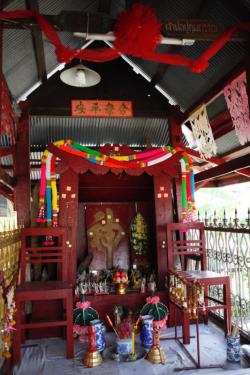
Chao Pho Shui shrine is one of the highly respected shrines in the community. KARNJANA KARNJANATAWE
In the past, Koh San Chao was a trading hub for farmers living on the west side of Bangkok to sell their produce or to deliver them to bigger markets along the Chao Phraya River such as Pak Khlong Talat. Things changed after more roads were built due to the city's expansion. People preferred to commute by car rather than boat.
After Boromratchonnanee Road was built about 30 years ago, rice paddies began disappearing while property projects have been sprouting like mushrooms and green areas are gradually being reduced.
The community stands behind a large property project on Boromratchonnanee Road. There is no road access to the community, except a walkway from Wat Champa. The path is wide enough for a motorcycle.
Some might think it is not convenient for commuting, but Thaweesak and locals living in the community prefer to keep it this way.
"We have small walkways inside our community, but a large green area. There is no road inside our village. Our community is quiet," he said.
Koh San Chao has being promoting the community as a tourist attraction since 2009. They have welcomed some well-known celebrities, including Urassaya "Yaya" Sperbund, Nadech Kugimiya and Coco Lee, a Hong Kong-born American singer. They all like the rural ambience, which is quite hard to find in Bangkok these days, Thaweesak said.
The first stop for tourists is Wat Champa, which dates back to the Ayutthaya period. It was renovated during the reign of King Rama III and decorated with Chinese porcelain and stucco art.
A short walk from the temple is a two-storey house called Ban Wangchan which belongs to Thaweesak. The house, which stands on a two-rai plot opens to the public at weekends. Thaweesak and his family members still live in the house so a few rooms are out of bounds for public viewing.
If visitors book in advance for a group tour, Thaweesak can arrange a lunch set cooked by his family. The meal includes mee kathi (rice vermicelli cooked with minced pork, dried shrimp, cubed tofu in coconut cream and garnished with sliced omelette, fresh Chinese chives and bean sprouts), tom kha kai (a sour chicken soup made with coconut cream and sliced banana blossom) and lon kung (a rich, coconut-cream based sauce with minced pork and sliced shrimp, served with fresh vegetables).
Thaweesak is also a skilful craftsman. He is the last artisan in the community who specialises in banana trunk carving. He learned how to carve from his father, Charoon, who learned the technique from Luang Watthanasilp, a royal court artisan, who fled the community to escape the bombings in Bangkok during World War II.
Banana trunk carvings are used to decorate a coffin and its platform. His latest craftwork was for the funeral of National Artist Angkarn Kalayanapong in 2012.
Thaweesak's carvings are always decorated with fruit carvings depicting dragons, nagas, crocodiles and paksa, a mythical bird.
"In the past, banana trunk carvings were widely used at funerals because we believed the trunk could reduce the smell of burnt flesh during the cremation," he said.
But that is not necessary today. As a result, it is hard to find a new generation who may want to learn how to carve banana trunks.
Just a few steps away from his house is a shrine called "Chao Pho Shui". The shrine faces the confluence of Bang Ramat and Ban Sai canals.
"Although we are Thai, we have Chinese beliefs so our ancestors built the shrine to honour the guardian of water. We call him 'Shui', which means water in the Chinese language," he said.
From the shrine, you need to cross a small bridge and walk a little bit further to another Thai-style house. Ban Khrueng Hom belongs to Thaweesak's younger sister. She is skilful at making paeng phuang (traditional scented powder garlands). The garlands are made from paeng hin, a by-product of salt.
The garlands can be used for decorations such as decorating a hairpin, making a floral wreath chandelier or even creating a wedding bouquet. The fragrance lasts for about two months.
The last stop is the house of Lamun, who is also known as Grandma Berm. She is 82 years old and in good health. Visitors to her house can learn how to make khanom kluay (a steamed snack made with banana, rice flour, coconut milk and shredded coconut).
At weekends, she sells the snack and other traditional Thai desserts, including khanom tom made of shredded coconut mixed with sugar and wrapped in a starchy batter before being steamed.
She and her niece sell the desserts along with other food at a pier area not far from the house.
The pier is where visitors from Lat Mayom floating market, a 30-minute boat ride from the community, disembark to visit the community.
As community leader, Thaweesak believes he has done his part which is to create a tourism opportunity for his community.
"When tourists visit us, it will encourage more locals to take care of their houses or even create jobs for them. I believe that sustainable tourism must be created and managed by the community and for the benefit of our community," he added.
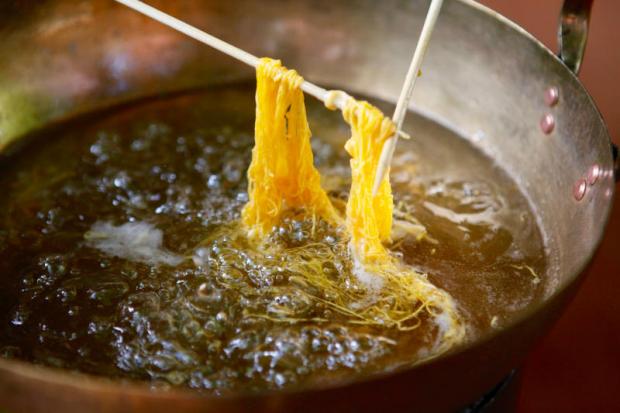
Visitors can try making foi thong (sweet golden treads made of egg yolk) and taste other types of Thai desserts like khao tu (a gummy dessert made with roasted rice) and khanom tan (yellow steamed dessert made of sugar, rice flour and the liquid of the sugar palm fruit, topped with grated coconut). KARNJANA KARNJANATAWE

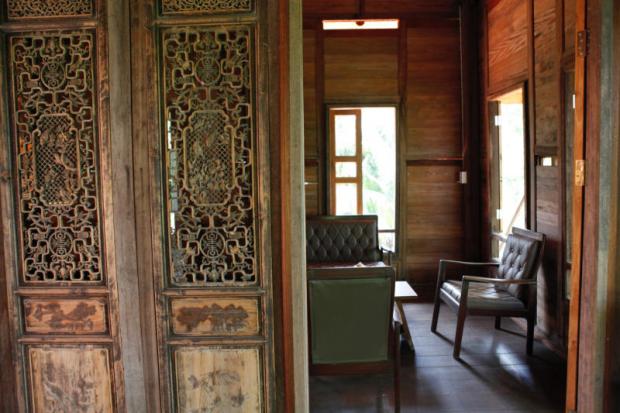
Ban Wangchan is open for visitors to explore the Thai-style house, without any charge at weekends and on public holidays. KARNJANA KARNJANATAWE
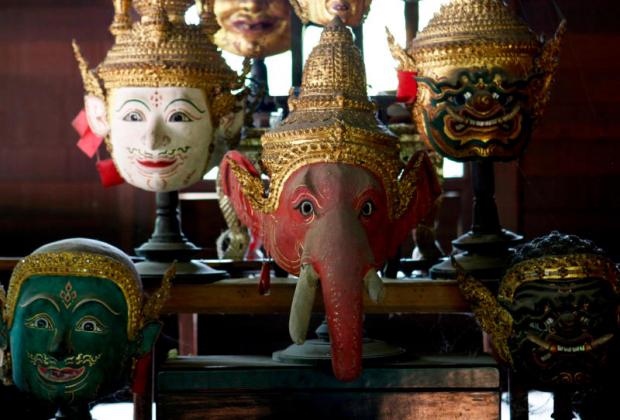
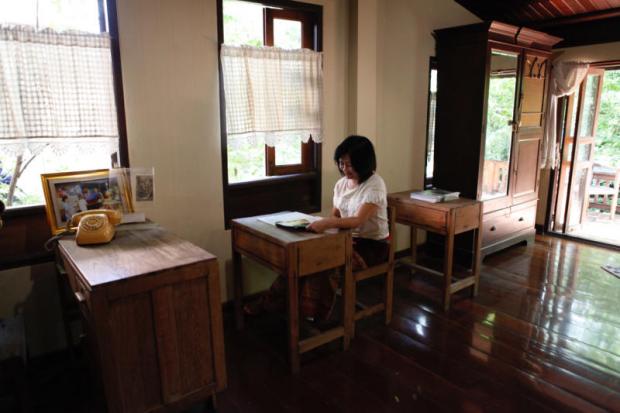

The bright orange spiky gac fruit, also known as baby jackfruit or fug khao in Thai, is one of the products of the community. The fruit is used to make a sweet, cold drink (15 baht per bottle) or soap (50 baht per piece). KARNJANA KARNJANATAWE

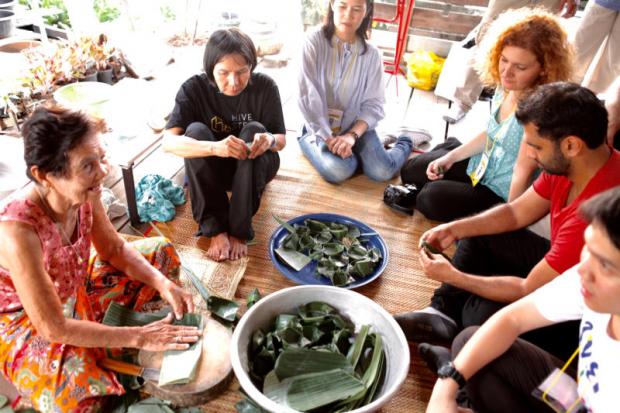
Grandma Berm teaches visitors how to cook khanom kluay. She and her niece instruct visitors on how to mix rice flour, sugar, salt, coconut shreds and ripe banana and steam the dessert. The cooking class lasts about two hours and everyone can taste their dessert while it is still hot. KARNJANA KARNJANATAWE
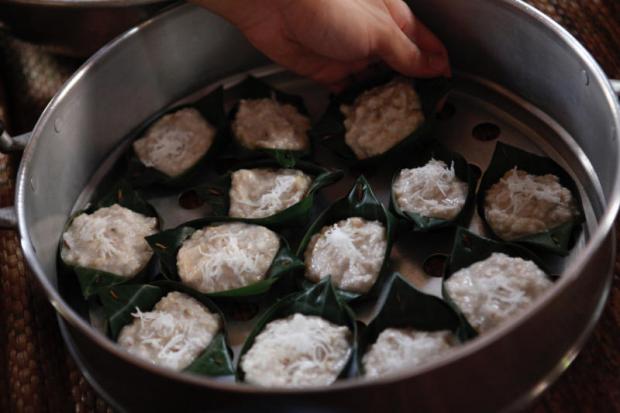
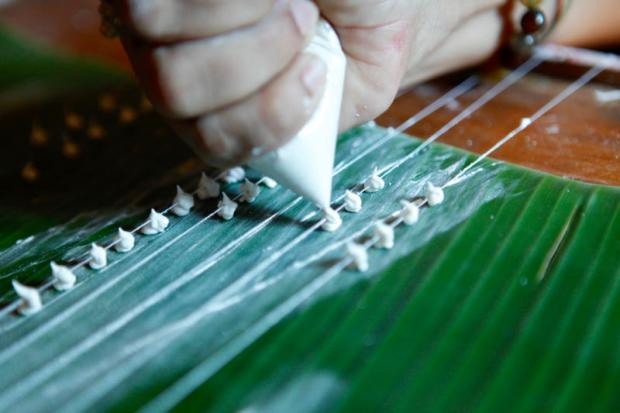
Visitors can try making paeng phuang at Ban Khrueng Hom. It is made of finely ground paeng hin (which is lighter in weight than din sophong or marl limestone). The powder is mixed with ground patchouli, chopped kaffir lime peels, scents of Thai flowers and water until it becomes creamy. The mixture is put it in a pipping bag. Pipe the mixture over a yarn, making little cone shapes one after another from the beginning to the end of the yarn. Leave it to dry for a couple of hours. Each finished yarn can be grouped together as a garland or used for decorations. KARNJANA KARNJANATAWE
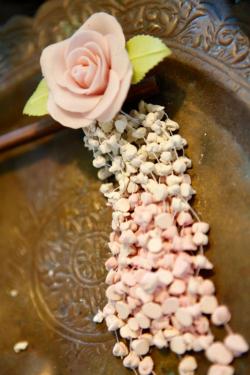

Thaweesak Wangchan shows his craftwork — a banana trunk carving with a dragon decoration made of pumpkin. The artisan is willing to teach the craftwork to those interested. KARNJANA KARNJANATAWE


Just outside the back door of Wat Champa, you will find this small food stall. The stall has been operated for 70 years. Owned by Tueanjai, it offers khanom bueang yuan, cooked over a charcoal stove. The snack is prepared by yellow batter in a wok with ground dried shrimps, bean sprouts, diced tofu and peanuts. The snack is served with sweet sauce with sliced cucumbers and shallots. KARNJANA KARNJANATAWE
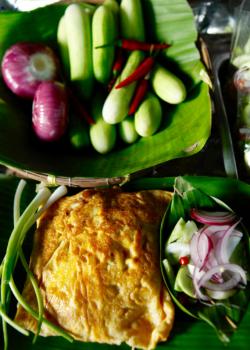

There are several traditional Thai-style houses in the community. While walking, watch out for motorcyclists and cyclists because they also use the path. KARNJANA KARNJANATAWE
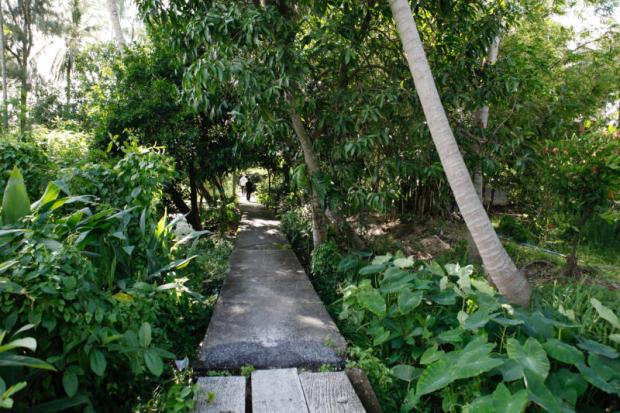
There are several traditional Thai-style houses in the community. While walking, watch out for motorcyclists and cyclists because they also use the path. KARNJANA KARNJANATAWE
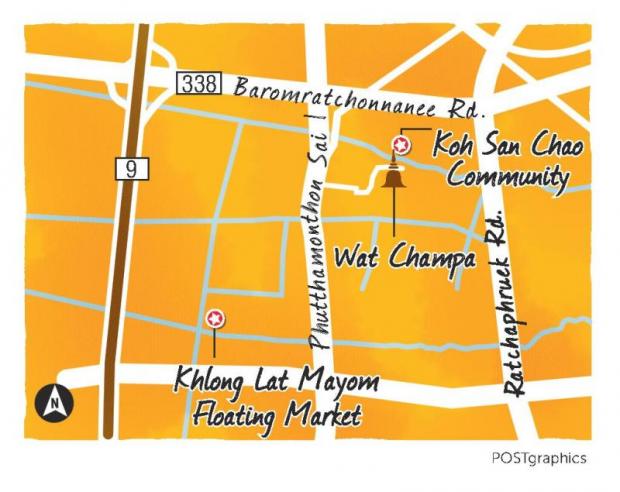
Travel Info
The walkway to Koh San Chao Community is behind Wat Champa. No public bus goes directly to the community or the temple. If travelling by bus, get off at the bus stop after Taling Chan Police Station and take a motorcycle taxi or a songthaew to the temple. Buses that ply on Boromratchonnanee Road are 123, 124, 125, 146, 149, 507, 511 and 516.
If travelling by private car, take Phutthamonthon Sai 1 Road heading to the Southern Bus Terminal and turn left to Soi Wat Pho (24) after passing a property project called Ban Nanthawan. Follow signs to Wat Champa for about 2km. Park the car at the temple and walk to the community.
Attractions in Koh San Chao community are open every weekend and on public holidays. For those visiting on weekdays or looking for homestays, call community chief Thaweesak Wangchan a day in advance on 087-0366-322.
For group tours with English translators, contact HiveSters, an online travel agent who initiated the "Appear" project, which launched last week to promote sustainable tourism in local communities, on 099-708-5695 or visit hivesters.com/appear.
